PDF Attached
WASHINGTON,
Sept. 7, 2021—Private exporters reported to the U.S. Department of Agriculture export sales of 327,300 metric tons of hard red winter wheat for delivery to Nigeria during the 2021/2022 marketing year.
Lower
trade on a higher USD, Gulf grain operations reopening, and expectations for USDA to report upward revisions to US corn and soybean crop production. Australia is expected to produce a very large wheat and canola crop. US corn conditions declined 1 point
to 59 (trade 60) and soybeans improved one point to 57 (trade 57).
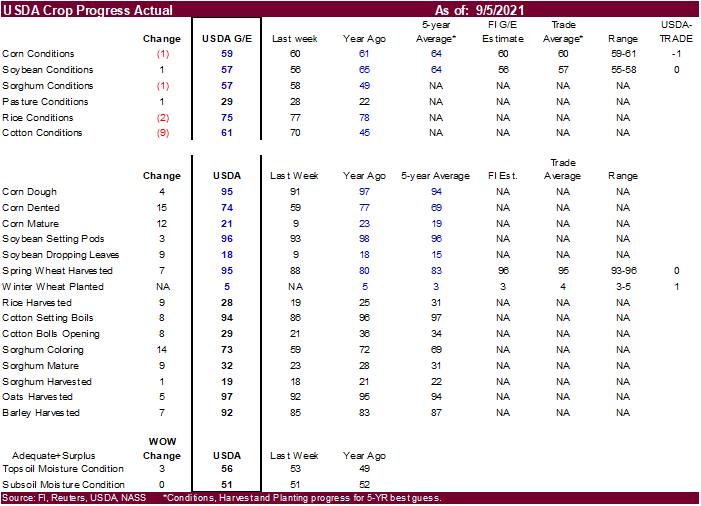
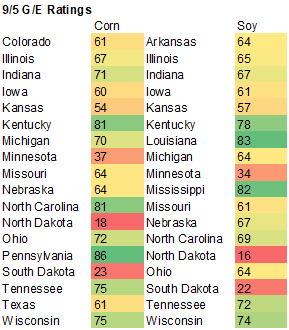
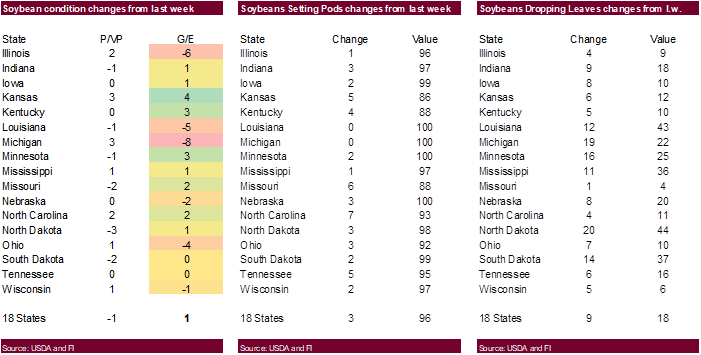
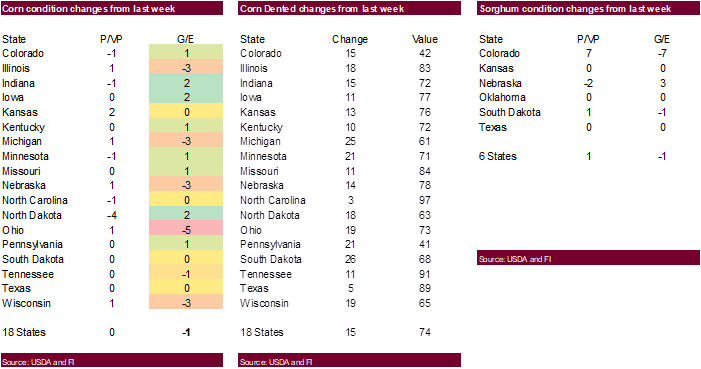
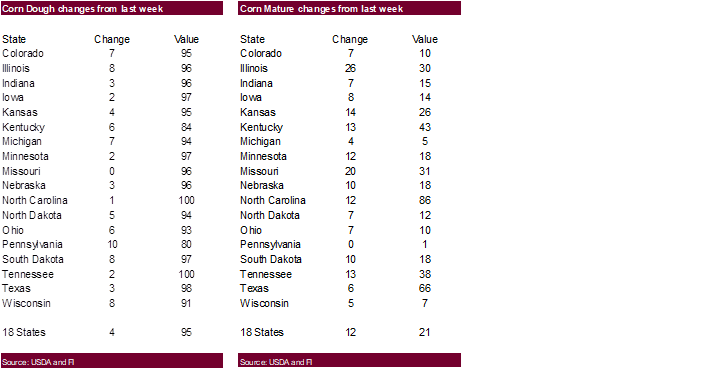
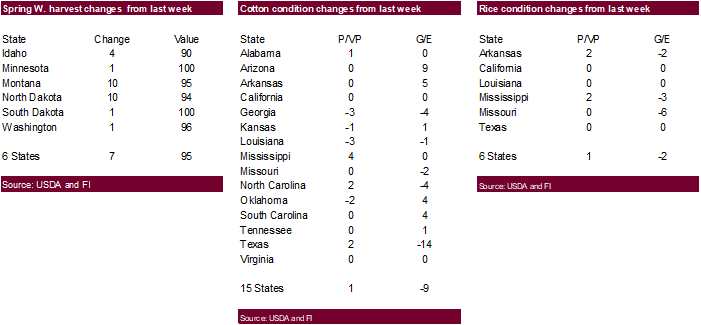

MOST
IMPORTANT WEATHER OF THE DAY
- India
is still facing two monsoon depressions and waves of heavy rain associated with each over the next ten days - Heavy
rain already occurred during the extended weekend from northeastern Andhra Pradesh to parts of Maharashtra where rainfall varied from 2.00 to more than 8.00 inches - Some
flooding may already be under way - The
greatest rainfall the remainder of this workweek will occur from Maharashtra to Gujarat and southern Rajasthan where 2.00 to 6.00 inches and local totals of 8.00 to more than 12.00 inches will result in flooding
- Gujarat
and northern Maharashtra will be wettest - Some
crop damage will be possible because of flooding - Monsoon
depression number two will move over the Odisha border from the Bay of Bengal early next week and move to eastern Gujarat and southern Rajasthan with rainfall of 2.00 to more than 6.00 inches occurring once again from northeastern Andhra Pradesh, southern
Odisha and southern Chhattisgarh to Gujarat and southern Rajasthan - A
few days of drying will occur between each of the monsoon depressions to help flood water recede a bit, but flooding is possible from both events causing some damage to summer crops; including rice, soybeans, groundnuts, cotton, corn, sorghum, pulses and others - Australia
needs greater rain in northern New South Wales, Queensland and northern parts of Western Australia to improve reproductive conditions for wheat and barley - Southern
Australia soil moisture is still rated favorably with little change likely
- Australia
rainfall was greatest in central and eastern Victoria crop areas and near the Great Dividing range during the weekend - Most
areas reported 0.05 to 0.79 inch with a few totals of 1.00 to 2.50 inches from central Victoria to south-central New South Wales - Eastern
Queensland rainfall was minimal - Western
Australia and parts of South Australia rainfall was minimal as well - Weekend
temperatures were warm in the east and seasonably mild elsewhere. - Europe
weather will be very good for harvest and early season winter crop planting over the next ten days - Eastern
Europe will dry out most for the next ten days and some winter crop areas in the Balkan Countries will continue in need of greater soil moisture, despite some relief in the past week or two
- Some
southern CIS winter crop areas will need significant rain soon to support wheat, rye and barley germination, emergence and establishment - Cool
weather during the weekend had little impact on recently planted winter crops and may have slowed summer crop maturation - Drying
recently has been supportive of quick summer crop maturation and harvest progress - Precipitation
over the next couple of weeks will be greatest in norther n and some central parts of the CIS - Additional
cool weather is expected for a while which may induce more frost and freezes - Weekend
frost and freezes in Russia and neighboring areas of Belarus and the Baltic States had no lasting impact on winter or summer crops - None
of the cold reached down into the more important summer crop areas where corn, soybeans and other crops are still finishing out their development - China
reported another weekend of excessive rain in northeastern Sichuan, Shaanxi, southern Shanxi, northern and eastern Henan, Shandong and northern Jiangsu
- Rain
totals since Friday in these areas ranged from 3.50 to more than 7.00 inches and local amounts reached up to 18.23 inches in northeastern Sichuan - Flooding
was serious in northeastern Sichuan - Rain
elsewhere in the Yellow River Basin and North China Plain was less than 2.50 inches.
- Net
drying occurred in the Northeast Provinces and in the interior southern parts of China through Sunday, although a few thunderstorms did occur south of the Yangtze River in pockets producing 0.30 to 1.25 inches
- One
location reported 3.70 inches of rain - Showers
increased in both the northeast and southern parts of China Monday, although no excessive amounts were noted
- Heilongjiang
was mostly dry during much of the weekend along with some areas near and south of the Yangtze River - Temperatures
were very warm in the drier areas of the south and seasonable elsewhere - East-central
China will be driest over the next ten days; including the middle and lower Yellow River Basin - Rainfall
in the Yangtze River Valley will be light and erratic as well, although some rain will fall in that region - Northeastern
China will get periods of rain over the next ten days and may be excessively wet at times - Drying
will be needed soon to protect summer crop quality and to induce better drying conditions ahead of the harvest season - Some
delay in early season fieldwork is expected because of rain - Tropical
Storm Conson was located 184 miles southeast of Manila at 0900 GMT today near 12.7 north, 123.0 east moving west northwesterly at 13 mph and producing maximum sustained wind speeds of 52 mph near its center.
- Rainfall
to more than 6.00 inches has already occurred in association with the storm in the central Philippines and more will fall through Wednesday before the storm exits from the region.
- Conson
will regain intensity as it moves out over open water in the South China Sea Thursday into the weekend - The
storm will ultimately move toward Hainan, China reaching there Saturday and Sunday and it may continue to move toward northern Vietnam with landfall there possible early next week - The
storm may become a typhoon again prior to reaching Hainan and if the storm misses Hainan it could reach Vietnam as a typhoon as well - Very
heavy rain and flooding will occur in parts of the Philippines and especially over Hainan, China where some damage may occur to sugarcane and rice in both countries - Damage
in the Philippines will be relatively light, but some loss to crops and property is possible - Typhoon
Chanthu was located 1142 miles southeast of the southern tip of Taipei, Taiwan near 16.2 north, 135.3 east moving west northwesterly at 12 mph and producing maximum sustained wind speeds of 74 mph - Tropical
Storm force wind was occurring out 50 miles from the center of the storm while typhoon force wind (greater than 74 mph) was occurring out 15 miles - Typhoon
Chanthu will move toward southern Taiwan over the next few days and could become a strong typhoon as the week progresses - The
storm will need to be closely monitored because of its potential impact on Taiwan and southeastern China - Landfall
in Taiwan will occur no sooner than Saturday, but the storm could begin influencing the island sooner than that - There
is some potential the storm will only skirt southern Taiwan and then move into Fujian China later in the weekend or early next week as a strong storm. - Damaging
wind and flooding rain will impact Taiwan as the storm passes to the south.
- Major
Hurricane Larry was located 830 miles southeast of Bermuda near 23.8 north, 55.1 west at 0900 GMT today. The storm was moving northwesterly at 10 mph producing maximum sustained wind speeds of 120 mph.
- Hurricane
force wind was occurring out 70 miles out from the center of the storm while tropical storm force wind speeds were occurring out 185 miles
- Larry
should pass to the east of Bermuda Thursday, but the storm will be large enough to produce some rough seas, strong wind and rain over Bermuda - The
weather in Bermuda is not likely to reach damaging proportions - Larry
will eventually move to Newfoundland, Canada Friday into the weekend - A
region of disturbed tropical weather continues to move away from the Yucatan Peninsula and toward the central Gulf of Mexico
- This
disturbance will bring some heavy rain and thunderstorm activity to the U.S. Florida upper coast and the Florida Panhandle later this week possibly resulting in some flooding - The
system is being closely monitored for additional development, but the environment may not be very supportive of an organized tropical cyclone – at least not based on the latest data until after the system crosses the southeastern United States later this week
and reaches the Atlantic Ocean - The
center of this disturbance was located 671 miles south southwest of Apalachicola, Florida at 0800 EDT today.
- U.S.
weather over the next seven days will be very good for Midwest, Delta and Great Plains summer crop filling, maturation and harvesting - Rain
is expected in the Great Lakes region only with 0.50 to 1.50 inches of rain expected from two weather disturbances that pass across the region - A
couple of frontal systems are expected to push through the Midwest during the second week of the forecast offer a little more rainfall, but most of the precipitation will be brief and light for the northern and central Plains and Midwest
- U.S.
temperatures in this coming week will be very warm to hot in the western U.S. from the high Plains region to the Pacific Coast excepting the Columbia River Basin where temperatures will be closer to normal - Temperatures
will be closer to normal in the Midwest, Delta and southeastern states with a few areas slightly cooler than usual - U.S.
temperatures next week will be warmer than usual in the Plains and interior western U.S. while seasonably warm to the east - The
bottom line for much of the U.S. key grain and oilseed production areas during the next two weeks will be favorable for late season crop development, crop maturation and harvesting, despite some greater rain potential next week. Wheat planting in the southwestern
Plains should advance well with quick emergence for areas that just received rain this weekend.
- U.S.
weekend rainfall was most significant from Colorado and parts of the Texas Panhandle to the lower Midwest and a few areas in the Delta - Rain
was greatest in parts of Kansas and Missouri where local flooding occurred Friday into Saturday
- Lighter
rain fell in the lower Midwest, but amounts in most of these areas ranged from 1.00 to 3.00 inches with local amounts of 3.00 to 6.64 inches with the interior southeastern parts of Kansas and west-central Missouri wettest
- Some
local totals of 1.00 to 4.00 inches also occurred in southeastern Missouri and 1.00 to 3.00 inches in interior southern Illinois - Rain
totals in most other areas was rarely more than 1.00 inch with many areas reporting less than 0.50 inch - Rainfall
in the northern Plains and upper Midwest was minimal and amounts in the Delta were erratic and light, although more than 1.00 inch fell in a few areas - The
southeastern states were dry from southern Alabama to North Carolina and West Virginia while Florida received some locally heavy rainfall
- West
Texas reported scattered showers with erratic rainfall and a few amounts of up to 1.40 inches. Most of the rainfall was too light and sporadic to seriously change soil moisture - Weekend
temperatures were warm in much of the nation, especially in the west and south-central states, though, where extremes in the 90s a few readings above 100 were noted - Drought
will continue in the northwestern Plains - California
and the interior Pacific Northwest will remain dry - Canada’s
Prairies received a restricted amount of rain during the weekend during the weekend favoring crop maturation and harvest progress - Temperatures
were mild to warm with many highs in the 70s and 80s Fahrenheit and lows in the upper 30s and 40s with a few lower 50s as well - Southern
Canada’s Prairies are not likely to receive much rain over the next ten days - Rain
will fall in southwestern and west-central Alberta and across some central Saskatchewan and Manitoba locations, but the resulting rain will be light - Drought
conditions will prevail in the southwestern Prairies - Ontario
and Quebec, Canada will experience a good mix of weather over the next two weeks supporting late season filling and maturation of summer crops - Central
America and southern and eastern Mexico will remain wet biased during the next ten days with near to above normal rainfall - A
tropical disturbance in the western Caribbean Sea late this week may move across the Yucatan Peninsula during the weekend and could become a tropical cyclone in the western Bay of Campeche during the weekend before impacting northeastern Mexico and southern
Texas later next week - Confidence
is very low - Argentina
rainfall through Wednesday will be greatest in Buenos Aires and La Pampa as well as from Uruguay to parts of Santa Fe, but rainfall elsewhere will be more limited for the next ten days
- The
moisture will be good for wheat and for future planting of early corn and sunseed - Rain
will still be needed in Cordoba, parts of Santa Fe and Santiago del Estero where dryness will remain significant - Most
of western Argentina still needs a general soaking rain - Brazil
rainfall will be heavy early today and again Sunday into Monday in Rio Grande do Sul where some flooding will be possible in some of its rice and corn production region areas - Rainfall
elsewhere in Brazil will be more restricted; however, Northern Mato Grosso may experience some periodic showers over the next ten days - Initial
rainfall in Mato Grosso will be too light for early autumn soybean planting, but the environment may improve next week and later this month - Flooding
in Rio Grande do Sul this week, could threaten some of the wheat crop, but only a small amount of spring planting has likely occurred so far and if there is any damage to those crops there would be plenty of time to replant - Coffee,
citrus and sugarcane areas will stay mostly dry for another week to ten days, although some showers will occur in Sul de Minas Friday and Saturday - South
America rain was mostly significant in interior southern Argentina and southern Brazil during the weekend - Rainfall
in Argentina through dawn Monday varied from 0.10 to 0.62 inch with a few amounts of 1.00 to 1.58 inches
- Most
of the rain occurred from southernmost Cordoba and La Pampa into Buenos Aires - Rainfall
in southern Cordoba ranged from 0.05 to 0.88 inch with most areas reporting less than 0.20 inch - Rainfall
in southern Brazil varied from 0.05 to 0.72 inch with most of that occurring from Rio Grande do Sul to western and southern Parana and southern Mato Grosso do Sul as well as southern Paraguay - Dry
weather occurred elsewhere - Brazil
temperatures heated up to the 90s and over 100 degrees Fahrenheit Friday through Sunday with extremes of 100 to 106 occurring in Mato Grosso and western Goias
- Argentina
temperatures were mild in the south and very warm in the north contrasting with highest afternoon temperatures in the upper 50s and 60s in the far south to the 80s and some 90s in the far north - Europe
weather during the weekend included limited rainfall and warm temperatures - Weather
this week is expected to continue warm with the greatest rain falling in France and Germany while other areas slowly dry out
- The
environment should be very good for late season summer crop development, maturation and harvest progress - CIS
weekend precipitation occurred from Belarus into western Russia and in the Ural Mountains region Friday through this morning - The
precipitation was mostly light, although a few 1.00 to 2.00-inch totals were noted - Net
drying occurred farther to the south in Ukraine, Russia’s Southern Region and the middle and lower Volga River Basin favoring summer crop maturation and harvest progress - Frost
and freezes occurred in portions of west-central and northwestern Russia during the weekend, but no serious harm was suspected to its unharvested crops or recently planted winter cereals - Cool
weather will continue in the western CIS this week with additional bouts of frost and a few freezes mostly in Russia - No
serious damage to crops will occur - Summer
crops in the south will not get cold enough for frost or freezes and no harm will come to the region - Spring
wheat and sunseed crops in the New Lands will also be subjected to frost and freezes for during the coming week to ten days, but crops should be mature enough to avoid any negative impact - Precipitation
in the CIS will be periodic, but light enough to have a limited impact on crops soil conditions during the next ten days - Some
disruption to harvesting is expected, but progress will be made - Winter
grain planting will also advance around the precipitation - Southeast
Asia rainfall will remain sufficient to carry on favorable crop development from the mainland areas into the Philippines and Indonesia and Malaysia during the next ten days - There
is some potential for excessive rain and flooding in a part of the Philippines and possibly in a few areas of mainland Southeast Asia - Flooding
rain is expected in Taiwan from Typhoon Chanthu - Rainfall
will be lightest in parts of Sumatra and Peninsular Malaysia where some net drying is possible and the region will need to be closely monitored - Temperatures
will be a little cooler than usual - New
Zealand will be extra wet this week while temperature are little cooler than usual - The
entire nation will be wetter than usual especially in South Island - Frost
and freezes were noted during the weekend, but there should not have been any negative impact on crops - Southern
Oscillation Index was +7.70 today and the index has been steady rising over the past week.
- This
week’s index will likely move a little more erratically and may drift lower for a little while - South
Africa rainfall should be mostly confined to the southeast early to mid-week this week with Natal most favored.
- West-Central
Africa will get sufficient rainfall during the next ten days to support its coffee, cocoa, rice sugarcane and other crops - Cotton
in west-central Africa is rated favorable and has likely yielded well this year
Source:
World Weather Inc.
Tuesday,
Sept. 7:
- USDA
export inspections – corn, soybeans, wheat, 11am - U.S.
crop conditions – corn, cotton, soybeans; spring wheat harvest, 4pm - China’s
first batch of August trade data, including imports of soy, meat and edible oils - New
Zealand global dairy trade auction - Australia’s
September crop report - U.S.
Purdue Agriculture Sentiment - EU
weekly grain, oilseed import and export data - HOLIDAY:
Brazil
Wednesday,
Sept. 8:
- Meat
Atlas 2021 – facts and figures about the animals people eat - Canada’s
StatsCan releases data on wheat, barley, canola and durum stockpiles
Thursday,
Sept. 9:
- USDA
weekly crop net-export sales for corn, soybeans, wheat, cotton, pork, beef, 8:30am - EIA
weekly U.S. ethanol inventories, production - Brazil’s
Conab report on yield, area and output of corn and soybeans - Port
of Rouen data on French grain exports - UkrAgroConsult
Black Sea oilseed conference
Friday,
Sept. 10:
- USDA’s
monthly World Agricultural Supply and Demand Estimates (WASDE) report, noon - China
farm ministry’s CASDE outlook report - ICE
Futures Europe weekly commitments of traders report (6:30pm London) - CFTC
commitments of traders weekly report on positions for various U.S. futures and options, 3:30pm - Malaysian
Palm Oil Board data on August stockpiles, output and exports - FranceAgriMer
weekly update on crop conditions - Malaysia
Sept. 1-10 palm oil export data - HOLIDAY:
India
Source:
Bloomberg and FI
US
inventories (Reuters)
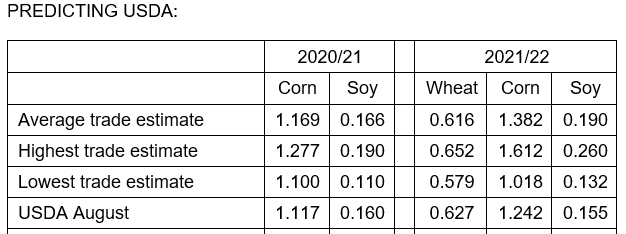
US
production (Reuters)
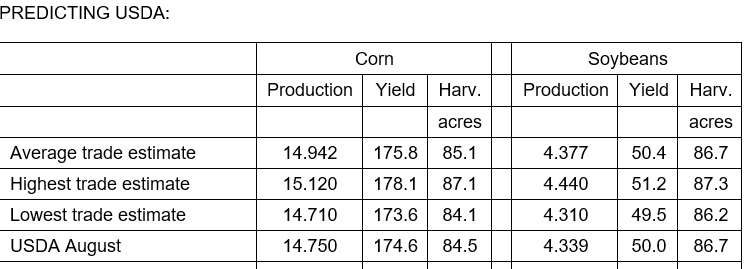
World
inventories (Reuters)
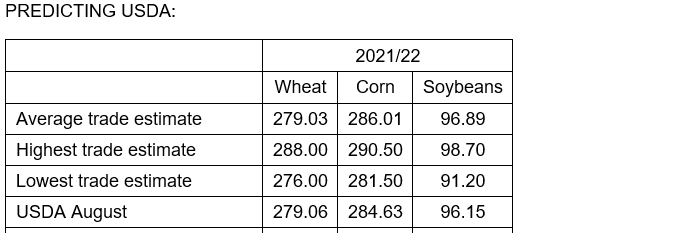
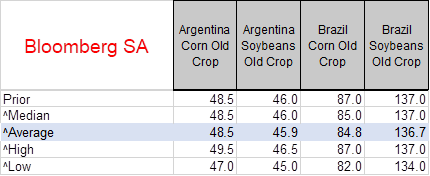
|
USDA |
||||
|
Wheat |
381,551 |
versus |
150000-525000 |
range |
|
Corn |
275,799 |
versus |
125000-550000 |
range |
|
Soybeans |
68,059 |
versus |
50000-250000 |
range |

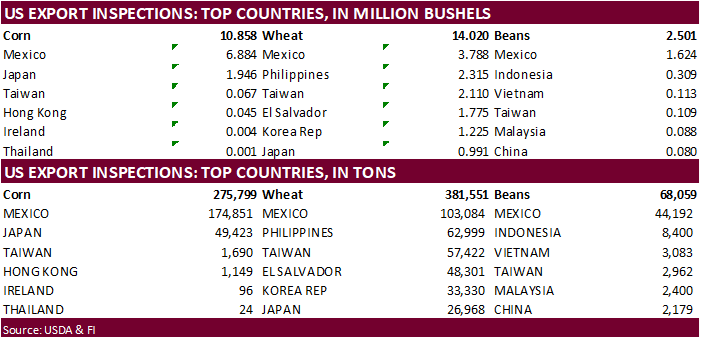
GRAINS
INSPECTED AND/OR WEIGHED FOR EXPORT
REPORTED IN WEEK ENDING SEP 02, 2021
— METRIC TONS —
————————————————————————-
CURRENT PREVIOUS
———–
WEEK ENDING ———- MARKET YEAR MARKET YEAR
GRAIN 09/02/2021 08/26/2021 09/03/2020 TO DATE TO DATE
BARLEY
0 0 1,996 6,550 5,727
CORN
275,799 583,498 887,889 39,453 271,920
FLAXSEED
0 0 72 24 389
MIXED
0 0 0 0 0
OATS
0 0 48 100 948
RYE
0 0 0 0 0
SORGHUM
3,831 74,186 33,144 1,317 33,096
SOYBEANS
68,059 386,839 1,512,819 18,778 682,227
SUNFLOWER
0 0 0 0 0
WHEAT
381,551 370,461 699,386 6,487,016 7,467,467
Total
729,240 1,414,984 3,135,354 6,553,238 8,461,774
————————————————————————-
CROP
MARKETING YEARS BEGIN JUNE 1 FOR WHEAT, RYE, OATS, BARLEY AND
FLAXSEED;
SEPTEMBER 1 FOR CORN, SORGHUM, SOYBEANS AND SUNFLOWER SEEDS.
INCLUDES
WATERWAY SHIPMENTS TO CANADA.

Due
out Wednesday morning
77
Counterparties Take $1079.945 Bln At Fed’s Fixed-Rate Reverse Repo (prev $1074.707 Bln, 74 Bidders)
·
Corn ended lower from the strength in the USD, bearish technical signals (head and shoulders), and US harvest pressure. It will be drier this week for the US than that of last week, especially in the south. We hear harvesting
activity for corn, rice and milo is at full steam in Arkansas near Memphis, TN.
·
We see support in December corn at $5.0350, then $4.90.
·
There was talk the US corn crop could improve after rains fell over the past week. Traders are already looking for higher corn harvested area to be reported by USDA on Friday.
·
US corn conditions declined 1 point to 59 (trade 60) and soybeans improved one point to 57 (trade 57). US corn conditions for the G/E categories of 59 compares to 61 year ago and 64 average. IL declined 3 points. NE was off
3 and OH was down 5. IN and IA improved 2 points. Corn dough was 95 percent versus 94 average, corn dented 74 percent, above 69 average, and corn mature 21 percent versus 19 percent average.
·
Funds sold an estimated net 11,000 corn contracts today.
·
USDA US corn export inspections as of September 02, 2021 were 275,799 tons, within a range of trade expectations, below 583,498 tons previous week and compares to 887,889 tons year ago. Major countries included Mexico for 174,851
tons, Japan for 49,423 tons, and Taiwan for 1,690 tons.
·
AgRural sees Brazil corn crop at 81.9 million tons from 82.2 previously, more than 20 million tons below last year’s 102.6-million-ton harvest. AgRural estimated Brazil’s first corn crop to be planted in 2.973 million hectares,
up 0.6% from the previous season.
·
AgRural reported the summer corn planted area is 10 percent complete.
·
China’s state planner said on Monday several provinces have bought up pork for their reserves and others plan to buy the meat during September as well as the fourth quarter. (Reuters)
·
China is hopeful Brazil beef exports will resume after 2 cases of mad cow disease were reported in Brazil over the weekend.
·
China August meat imports fell 9 percent to 758,000 tons from year earlier and compares to 854,000 tons during July 2021. China has imported 6.69 million tons of meat for the first eight months of the year, up 1.7% from the same
period a year ago.
·
(Bloomberg) — China’s top agricultural think tank reduced its estimate for the country’s corn consumption in 2020-21 as high prices bolstered the use of substitutes in animal feed. The China National Grain & Oils Information
Center cut its forecast for domestic corn demand by 2 million tons to 276 million tons in the marketing year ending September.
Export
developments.
·
China plans to sell 133,753 tons of US corn on September 10 and 8,277 tons from Ukraine.
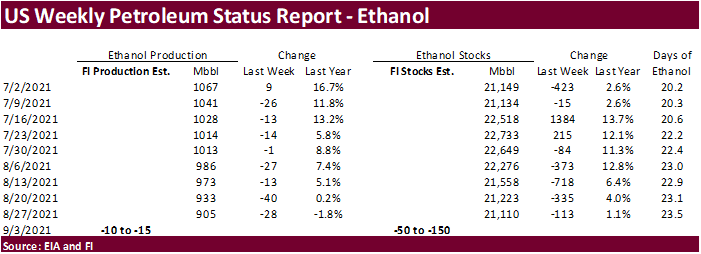

Updated
8/20/21
December
corn is seen in a $4.75-$6.00 range
·
US soybean complex traded lower despite US Gulf loadings starting to resume. USDA export inspections were poor, as expected. We are hearing a cargo of soybeans is loading at Port Allen, and many more terminals are back up and
running. A
sharply higher USD added pressure to the soybean complex. Basis is starting to ease at the Gulf.
·
Funds sold an estimated net 7,000 soybeans, 1,000 meal and 3,000 soybean oil.
·
US corn conditions declined 1 point to 59 (trade 60) and soybeans improved one point to 57 (trade 57). US soybean conditions for the G/E categories of 57 compares to 65 year ago and 64 average. Il was down 6 points, LA down
5, MI down 8 and OH down 4. KS improved 4 points. Soybeans setting pods were 96 percent versus 96 average and soybeans dropping leaves were 18 percent versus 15 average.
·
USDA US soybean export inspections as of September 02, 2021 were 68,059 tons, within a range of trade expectations, below 386,839 tons previous week and compares to 1,512,819 tons year ago. Major countries included Mexico for
44,192 tons, Indonesia for 8,400 tons, and Vietnam for 3,083 tons.
·
Soybean inspections for the week ending September 2 out of the Gulf were zero. Corn was 108,444.
·
China August soybean imports were 9.49 million tons, slightly below 9.6 million tons during August 2020 and compares to 8.67 million in July.
·
Ukrainian sunflower oil exports totaled 5.277 million tons in 2020-21 (September to August), according to the national sunflower oil producers’ association, down from 6.684 million in 2019-20. 2021-22 exports are expected to
top 6 million tons.
·
Argentina raised their domestic prices for bioethanol and biodiesel that are mandatory to mix with gasoline and diesel. Bioethanol from sugar cane or corn was set at 59.35 pesos per liter (around $0.61), from a previous level
of 55.663 pesos per liter. Biodiesel was raised to 122,453 pesos per ton ($1,251) for September for mixture with diesel, rising to 124,900 pesos for October and 127,400 pesos in November. The previous price, set in July, was 112,000 pesos per ton. (Reuters)
·
Brazil was on holiday today.
·
Brazil 2022 soybean forward sales reached 26 percent or 36.3 million tons of the Safras projected new-crop crop production of 142.2 million tons, well down from 49 percent at this time a year ago. 2020-21 soybean crop was 86
percent sold (Safras).
·
ABARES estimated Australia’s canola crop at 5 million tons, up 20 percent from their June projection.
·
Strategie Grains reduced slightly its EU rapeseed production to 16.93 million tons from 17.03 million.
·
MPOB estimated the 2021 Malaysia palm oil at 18MMT vs 19.14 million for 2020. Exports were estimated at 16.3 vs 17.37 last year. Stocks were pegged at 1.7 million. The average palm oil prices was pegged at 4000 ringgit per
MT.
USDA
Attaché: European Union – Oilseeds and Products Semi-Annual Report

Export
Developments
- None
reported

Updated
8/31/21
Soybeans
– November $11.75-$14.50 range
Soybean
meal – December $320-$395
Soybean
oil – December 52-65 cent range
·
Wheat futures ended lower on a firm USD (+48 by 2 pm CT) and large Australian crop production estimate. Some of the US received rain across parts of the HRW wheat area over the weekend. This created a stir in KC/Chicago wheat
spreads but the December spread settled down to go out at 2.25 Chicago wheat premium. Australia sees their wheat crop to end up second largest on record. Global demand remains robust. After the close Egypt announced they seek wheat.
·
Some areas of the US HRW wheat area remain too dry to start plantings and we think KC December wheat has a chance to trade at a premium over Chicago if US Great Plains weather fails to improve. We raised our trading range for
KC wheat.
·
US winter wheat plantings were reported at 5 percent complete, one point above expectations and compares to 5 year ago and 3 percent average.
·
US spring wheat is 95 percent harvested at expectations and well above 83 percent average.
·
Funds sold an estimated net 4,000 Chicago SRW wheat contracts.
·
USDA US all-wheat export inspections as of September 02, 2021 were 381,551 tons, within a range of trade expectations, above 370,461 tons previous week and compares to 699,386 tons year ago. Major countries included Mexico for
103,084 tons, Philippines for 62,999 tons, and Taiwan for 57,422 tons.
·
December Paris wheat was unchanged at 242.25 euros.
·
USDA reported private exporters sold 327,300 tons of hard red winter wheat to Nigeria. Last USDA sale of HRW wheat was on January 21 of 138,000 tons to the same country.
·
France sees their soft wheat crop at nearly 36 million tons, up 23 percent from last year. Quality remains very mixed after heavy rains fell during harvest season.
·
Australia is on track to harvest a near record wheat crop wheat this season, according to ABARES. They took wheat production up about 17% to 32.63 million tons (second largest on record and up from 27.8 million June estimate)
following recent favorable weather.
·
Australia’s western wheat crop saw frost over the weekend that may have an impact on production. This weekend frost event was compared to a 2016 event when the crop saw a 1-million-ton reduction, according to a Thomas Elder Markets
newsletter. https://www.thomaseldermarkets.com.au/grain/market-morsel-jack-frost-strikes-at-wa-crop/
·
Russian wheat export prices rose for the eighth consecutive week due to higher export tax and good domestic demand. IKAR showed 12.5% protein up 0.50/ton to $299.50 per ton and SovEcon reported wheat prices up $3.00/ton to $301/ton.
·
Russia’s AgMin noted grain exports during the July 1 to September 2 period fell to 6.7 million tons from 8.7 million a year earlier, led by an 18 percent decline in wheat shipments to 5.8 million tons.
·
Ukraine winter grain plantings started and the winter wheat area is off to a good start. A total of 7.8 million hectares of winter grains, including 6.68 million hectares of winter wheat, are expected to be sown, according to
the AgMin.
·
Kazakhstan’s president said it’s too early to set export duties on grains.
Export
Developments.
·
Egypt seeks wheat for October 25 through November 3 shipment.
·
Under the 24-hour USDA announcement system, private exporters sold 327,300 tons of hard red winter wheat for delivery to Nigeria during the 2021/2022 marketing year.
·
The Philippines seek 112,000 tons of animal feed wheat on Sept. 9 for shipment in September and October in two 56,000 tons consignments.
·
Pakistan is tendering for 550,000 tons of wheat and they are seeing offers at around $369.50/ton and $386.60/ton.
·
Turkey bought 245,000 tons of animal feed barley at between $294 and $306.90/ton for Sep 15-Oct 8 shipment.
·
Algeria seeks at least 50,000 tons of barley on September 8 for October shipment.
·
South Korea bought US and Australian and on Friday. An estimated 72,430 tons of milling wheat to be sourced from the United States and about 50,000 tons from Australia was noted.
·
Jordan seeks 120,000 tons of wheat, set to close September 8 for late December through February 14 shipment.
·
Jordan’s seeks 120,000 tons of animal feed barley on September 9 for Dec-Feb shipment.
·
Bangladesh’s state grains buyer seeks another 50,000 tons of milling wheat on September 16.
·
Mauritius seeks 47,000 tons of wheat flour, optional origin, on Sept. 21 for various 2022 shipment.
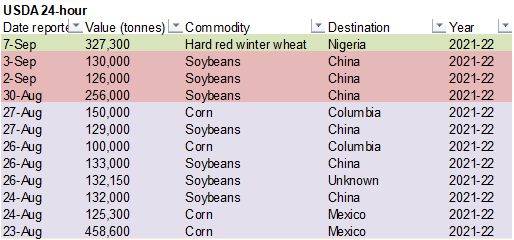
Rice/Other
- South
Korea seeks 42,200 tons of rice for arrival in South Korea between February 28 and April 2022. 20,000 tons of that is of US origin, rest optional .
- (Bloomberg)
— U.S. 2021-22 cotton production seen at 17.69m bales, 428,000 bales above USDA’s previous est., according to the avg in a Bloomberg survey of nine analysts.
Estimates
range from 17m to 18.45m bales
U.S.
ending stocks seen increasing by the same amount
Global
ending stocks seen 438,000 bales higher at 87.67m bales
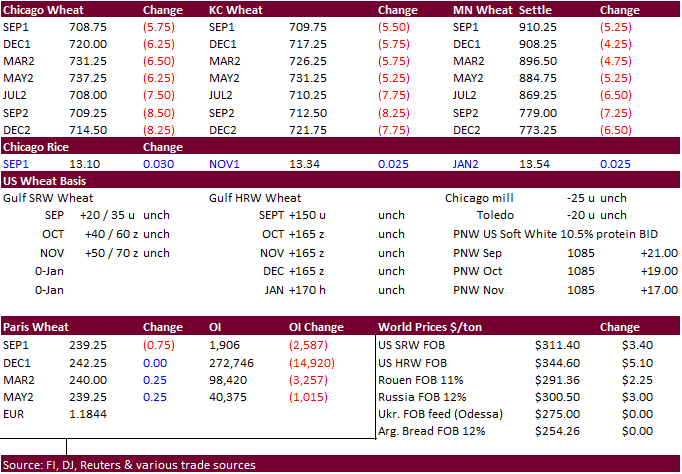
Updated 9/7/21
December Chicago wheat is seen in a $6.80‐$8.00
range
December KC wheat is seen in a $6.80‐$8.15
(up 20, up 35)
December MN wheat is seen in a $8.45‐$9.50
Terry Reilly
Senior Commodity Analyst – Grain and Oilseeds
Futures International
One Lincoln Center
18 W 140 Butterfield Rd.
Oakbrook Terrace, Il. 60181
W: 312.604.1366
ICE IM:
treilly1
Skype: fi.treilly

Trading of futures, options, swaps and other derivatives is risky and is not suitable for all persons. All of these investment products are leveraged, and you can lose more than your initial deposit. Each investment product is offered
only to and from jurisdictions where solicitation and sale are lawful, and in accordance with applicable laws and regulations in such jurisdiction. The information provided here should not be relied upon as a substitute for independent research before making
your investment decisions. Futures International, LLC is merely providing this information for your general information and the information does not take into account any particular individual’s investment objectives, financial situation, or needs. All investors
should obtain advice based on their unique situation before making any investment decision. The contents of this communication and any attachments are for informational purposes only and under no circumstances should they be construed as an offer to buy or
sell, or a solicitation to buy or sell any future, option, swap or other derivative. The sources for the information and any opinions in this communication are believed to be reliable, but Futures International, LLC does not warrant or guarantee the accuracy
of such information or opinions. Futures International, LLC and its principals and employees may take positions different from any positions described in this communication. Past results are not necessarily indicative of future results.

